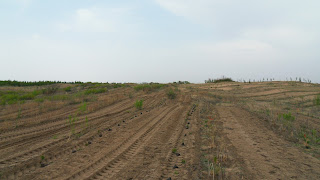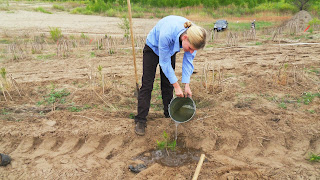Until about 60 years ago, Ke´erqin 科尔沁 in Inner Mongolia was covered with grass plains and smaller forests. Mongolian nomads were roaming through this area every now and then with their herds. Then they were forced (or "encouraged" ) to settle down by the Chinese government. China`s northeast has arid climate and strong winds, bringing in sand from the nearby Gobi desert, especially in spring. As the Mongolians (and Chinese) settled down, built villages, cultivated the land and raised and increased their herds, they used up too much of the scarce water, too many trees were cut down for firewood and construction, and the thin layers of fertile soil got blown away by the the desert winds and replaced by sand.
The result is the Ke´erqin "sandy land".
In fact a deforested (or "deplained" ) spot of land, but unlike a real desert it`s not too late yet to do something about it.
That`s where we came in - a group of about 40 people consisting of students of the Japanese language department and a handful of foreign teachers, spending a weekend for a, well, kind of a "infotainment action tour" to try to reverse the ongoing desertification of parts of Inner Mongolia at least a tiny little bit. And have fun while doing it.
Ke´erqin desert and the neighbouring town of Ganqika (甘旗卡) are about 300 km northwest from Shenyang, in the border region of the provinces Liaoning and Inner Mongolia. After a four hour busride
and "lunch on the bus" (see the following picture), we arrived at a section where for a couple of years now reforestation action is taken.
Every year a little more terrain is conquered back from the desert by planting long rows of young trees and ensuring the water supply for the dryest months of the year in spring. The coming year then more trees are planted in the neighbouring area.
So we had to walk through already reforested terrain for a while to get to the spot where we were supposed to plant new trees:
And then it`s just three more simple steps:
1. Take shovel, dig hole.
2. Put young tree in the hole, put soil back in the hole.
3. Give the little fella a good start by pouring a bucket of water over him.
Do this with a bunch of people and in about an hour you get already about 300 trees planted:
If these measures will do any good long-term and stop desertification in the area, I guess only time will tell. At least we tried. A little.
To get a feeling for how fertile the soil and the whole region once was and hopefully one day can be again, we made a stop at the only one hour away Daqinggou (大青沟) primeval forest, a habitat that could be preserved:
The next day it was time for the fun part - horse riding in the sandiest part of Ke´erqin desert. We were each equipped with a horse and a Mongolian guide and then took off for a one hour "stroll" through the dunes:
And for the atmospheric finish of this post, a single mongolian rider in the dunes:
The result is the Ke´erqin "sandy land".
In fact a deforested (or "deplained" ) spot of land, but unlike a real desert it`s not too late yet to do something about it.
That`s where we came in - a group of about 40 people consisting of students of the Japanese language department and a handful of foreign teachers, spending a weekend for a, well, kind of a "infotainment action tour" to try to reverse the ongoing desertification of parts of Inner Mongolia at least a tiny little bit. And have fun while doing it.
Ke´erqin desert and the neighbouring town of Ganqika (甘旗卡) are about 300 km northwest from Shenyang, in the border region of the provinces Liaoning and Inner Mongolia. After a four hour busride
and "lunch on the bus" (see the following picture), we arrived at a section where for a couple of years now reforestation action is taken.
Every year a little more terrain is conquered back from the desert by planting long rows of young trees and ensuring the water supply for the dryest months of the year in spring. The coming year then more trees are planted in the neighbouring area.
So we had to walk through already reforested terrain for a while to get to the spot where we were supposed to plant new trees:
And then it`s just three more simple steps:
1. Take shovel, dig hole.
2. Put young tree in the hole, put soil back in the hole.
3. Give the little fella a good start by pouring a bucket of water over him.
Do this with a bunch of people and in about an hour you get already about 300 trees planted:
If these measures will do any good long-term and stop desertification in the area, I guess only time will tell. At least we tried. A little.
To get a feeling for how fertile the soil and the whole region once was and hopefully one day can be again, we made a stop at the only one hour away Daqinggou (大青沟) primeval forest, a habitat that could be preserved:
The next day it was time for the fun part - horse riding in the sandiest part of Ke´erqin desert. We were each equipped with a horse and a Mongolian guide and then took off for a one hour "stroll" through the dunes:
And for the atmospheric finish of this post, a single mongolian rider in the dunes:






















